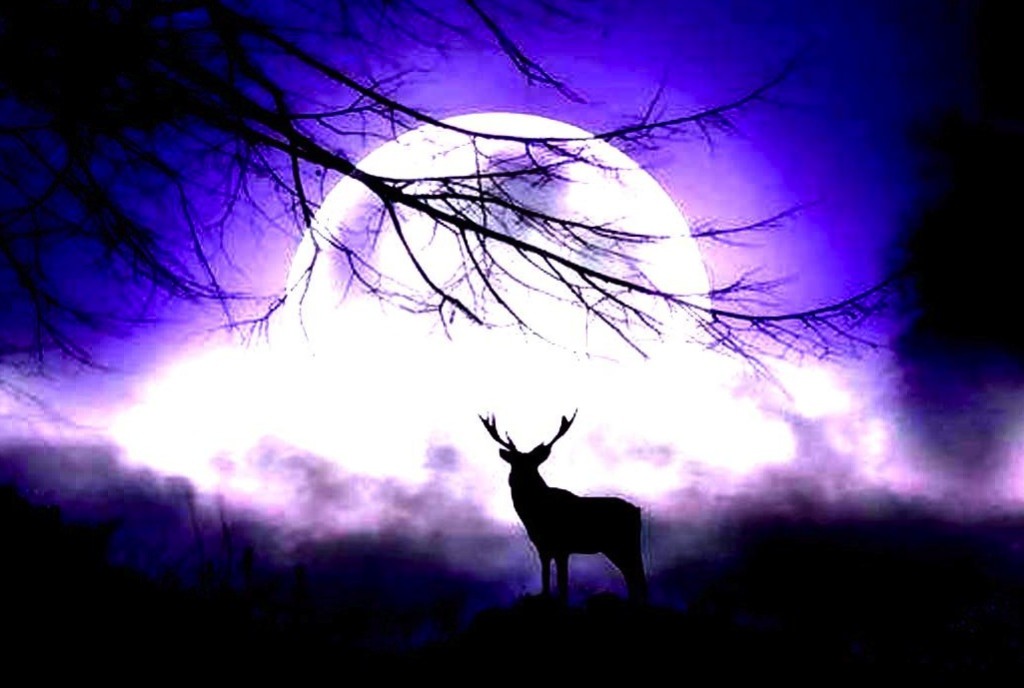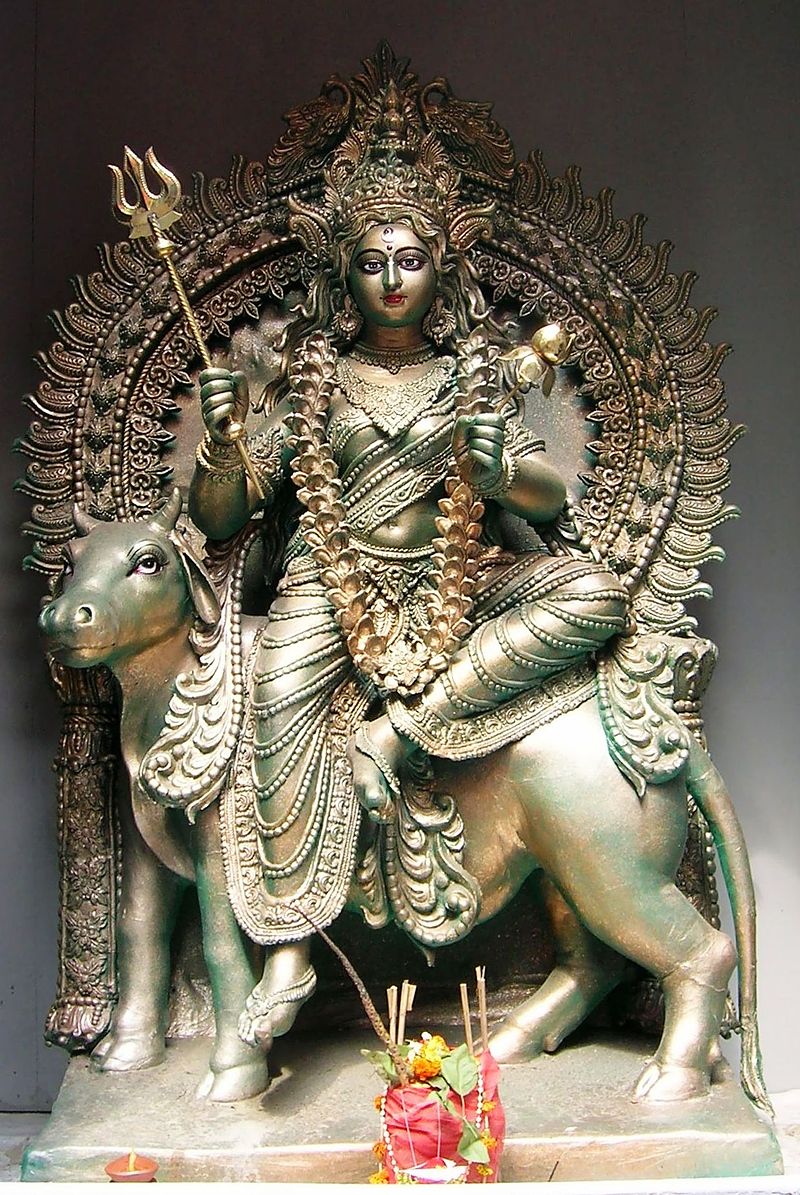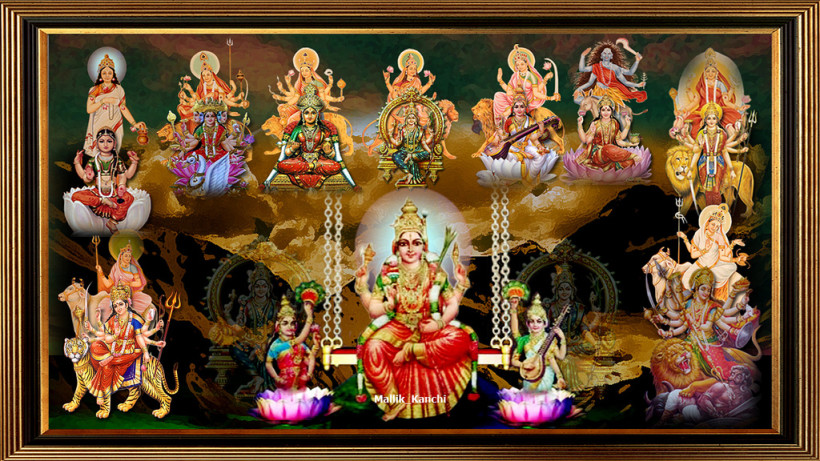
by Somya Devi | Oct 12, 2015 | Astrology, Holy Days
For the first nine days and nights of the waxing Moon this lunar cycle we celebrate Navaratri (starting October 13th in North America). Literally the “nine nights,” this is a Hindu festival dedicated to worshipping the Goddess, Devi, in her many forms, for nine days and nights. There are nine forms of Durga that are typically celebrated each day. We celebrate the power of Shakti, the sacred dynamic feminine principle of divine energy. We pray to her to help reveal and remove our shortcomings, bestow blessings, and confer wealth and knowledge. Navaratri worship can include many forms of puja (ritual prayer). These can include creating a special altar to the Goddess, and making daily offerings including flowers, food, incense, light (a flame), ghee, as well as prayer, meditation, mantras and bhajans (devotional songs). The Devi Mahatmyam (a.k.a. Chandi Path), the story of Durga, is a traditional text to read throughout this festival. Occurring in the fall-time in India and the northern hemisphere, this Navaratri also coincides with the harvest season, and is a time to give thanks for the abundance of the harvest and pray that it carries us through the winter season.
Goddess is worshipped over the nine nights in the form of nine incarnations of Durga (Navadurga). These are Shailputri, Brahmacharini, Chandraghanta, Kushmanda, Skandamata, Katyayani, Kalaratri, Mahagauri and Siddhidatri. Below are the stories of these goddesses, how to worship them, what they represent, as well as what colors and planets are associated with the nine days of Navaratri.
In many places, worship is dedicated to Goddess as Durga, Lakshmi and Sarasvati, for three nights each. Durga helps us to destroy and remove negative tendencies in our minds and hearts, cleansing them of impurities that create obstructions in our spiritual and material pursuits. Lakshmi helps us to cultivate positive qualities, like compassion and devotion. She helps us to achieve spiritual and material prosperity. Sarasvati assists us with learning and attaining knowledge and wisdom, through the illumination of consciousness. She relates to prana, the vital breath, often associated with chi or life-force. Through our devotion, service, practice, study, and meditation, we allow prana to flow freely and enter a state of peace, bliss, and oneness. The tenth day of Navaratri is known as Vijayadashami, the day of victory, and is a time for auspicious beginnings after emerging from these nine days of worship and union with the Goddess.
May your connection to the Divine Mother and Shakti within deepen and blossom during this time. Jai Ma!
First Day of Navaratri: Goddess as Shailputri
Tuesday, October 13th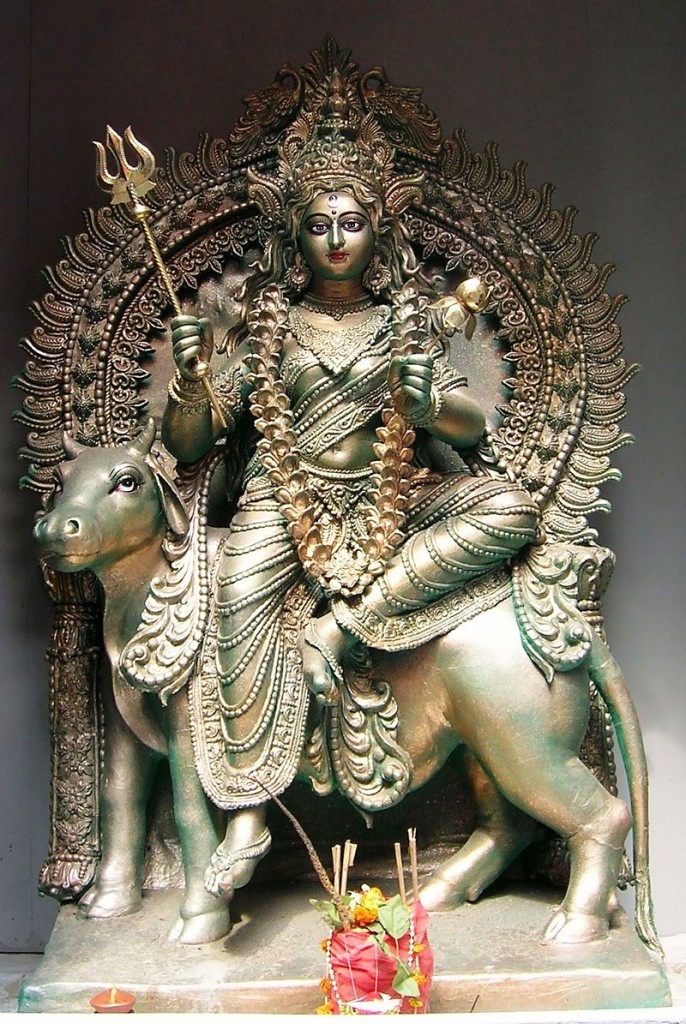
On the first day of Navaratri, On the first day of Navaratri, we honor Goddess in the form of Shailputri (a form of Durga), the “daughter of the mountains.” In the story of Shiva and Shakti, Shiva’s wife first incarnated as Sati, but Sati ended up sacrificing herself in a ceremonial fire because of her father’s (Daksha’s) disapproval of her husband. It was foretold that she would be born again to a father who respected the divine ascetic, and thus she reincarnated as Parvati, also called Hemavati (the daughter of Himavat, personification of the Himalayan mountains), or Shailputri (literally “daughter of the mountain”).
Shailputri rides a bull, Nandi, and carries a trident and a lotus in her hands. She rules the Moon (Chandra) and wears a crescent Moon on her forehead, just like her consort, Shiva. She is the mother of Kartikeya and Ganesha, and thus represents creative energy. She relates to the muladhara (root chakra), where we begin the journey of awakening the divine energy within, in the process of letting it rise into union with divine consciousness. It is good to concentrate on the root chakra today. Shailputri is a fitting goddess to worship for initiations and auspicious beginnings, and for the first day of Navaratri, as we are beginning the process of awakening Shakti. Devi’s color is red, which can be worn on all the nights of Navaratri, especially tonight.
Second Day of Navaratri: Goddess as Brahmacharini
Wednesday, October 14th
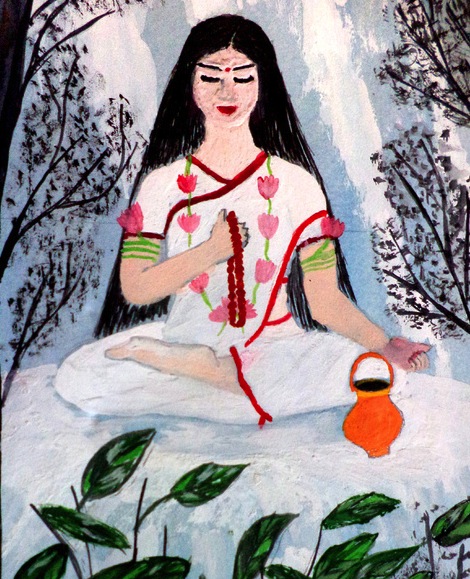 On the second day of Navaratri we worship Goddess as Brahmacharini, she who practices penance. Another form of Parvati and Durga, Brahmacharini is the form of the goddess who endured tapas or austerities (penance) to win the heart of Lord Shiva (representative of sublime consciousness). As he was an ascetic dedicated to austere meditations in solitude, the high-born Parvati forsook her father’s wealthy abode and chose the sadhu life of self-discipline and renunciation in order to attain spiritual growth. She went to live in the forest, enduring the elements, forgoing food and water, and meditating for eons. Brahmacharini is depicted in bare feet, holding a japa mala (prayer beads), and a kamandal (a simple water-pot, often carried by sadhus), and wearing rudrakshas (the bead related to Shiva and renunciation).
On the second day of Navaratri we worship Goddess as Brahmacharini, she who practices penance. Another form of Parvati and Durga, Brahmacharini is the form of the goddess who endured tapas or austerities (penance) to win the heart of Lord Shiva (representative of sublime consciousness). As he was an ascetic dedicated to austere meditations in solitude, the high-born Parvati forsook her father’s wealthy abode and chose the sadhu life of self-discipline and renunciation in order to attain spiritual growth. She went to live in the forest, enduring the elements, forgoing food and water, and meditating for eons. Brahmacharini is depicted in bare feet, holding a japa mala (prayer beads), and a kamandal (a simple water-pot, often carried by sadhus), and wearing rudrakshas (the bead related to Shiva and renunciation).
Although fasting is a suitable practice for all nine days of Navaratri (some fasts include milk or milk and fruit), it is especially potent to offer oneself to Goddess by fasting today. By worshipping Brahmacharini through simple offerings, prayer, and our own self-discipline, she blesses us with emotional and spiritual strength, and the ability to persevere through hardships. She represents and offers us loyalty, devotion, and spiritual growth and wisdom. She rules the planet Mars (Mangala), the planet of strength and courage, who assists us in overcoming weakness and practicing yogic discipline. The term brahmacharini also refers to female renunciates in the Hindu faith, who choose a life of tapas (austerity) and dedication to the Lord, rather than worldly life.
Third Day of Navaratri: Goddess as Chandraghanta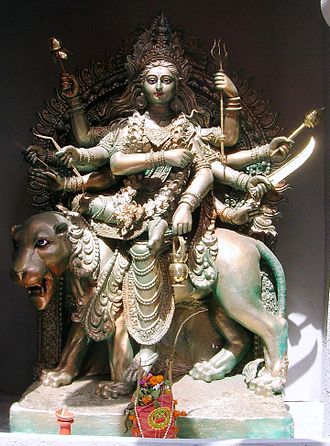
Thursday, October 15th
On the third day of Navaratri we celebrate Goddess as Chandraghanta, a powerful form of Durga. She wears a half-Moon (Chandra) in the shape of a bell (ghanta) oh her forehead. Riding a lion or a tiger, she has 10 arms in which she holds many weapons, as well as a japa mala, a lotus, a kamandal, and mudras (hand-positions) offering blessings and protection. Posed as a warrioress, she is ready to destroy the obstacles and enemies of her devotees. She rules the planet Venus (Shukra), and is truly a gentle goddess. Chandraghanta is full of love and compassion, and wants to bestow happiness and prosperity on those who worship her. This form of the Divine Mother brings us courage as well as grace and beauty. Worshipping her helps to remove suffering and to grant us serenity.
Fourth Day of Navaratri: Goddess as Kushmanda
Friday, October 16th
 On the fourth day of Navaratri we celebrate Goddess as Kushmanda, the power of Shakti that created the universe. It is said that when there was only darkness, Kushmanda smiled and the universe was illuminated. She is known as Adi Shakti, the first Shakti, creatrix of everything. She resides in the center of the Sun (Surya), and creates his bright light from her “cosmic egg.” She is radiant and glowing, and spreads warmth as well as vitality to her devotees. Kushmanda rides a lion or tiger and has 8 arms, holding many weapons, as well as a lotus, a japa mala, and a pot of honey or divine nectar.
On the fourth day of Navaratri we celebrate Goddess as Kushmanda, the power of Shakti that created the universe. It is said that when there was only darkness, Kushmanda smiled and the universe was illuminated. She is known as Adi Shakti, the first Shakti, creatrix of everything. She resides in the center of the Sun (Surya), and creates his bright light from her “cosmic egg.” She is radiant and glowing, and spreads warmth as well as vitality to her devotees. Kushmanda rides a lion or tiger and has 8 arms, holding many weapons, as well as a lotus, a japa mala, and a pot of honey or divine nectar.
Worshipping Kushmanda helps us to feel the spark of divine existence that radiates from the Sun to and through us all. She helps us to attain strength, good health, happiness and spiritual illumination. She is said to bestow siddhis (special powers) and thus can assist us in achieving success in many areas of life, including wealth, material comfort, and relationships. The power of the Sun enhances our positive and sattvic qualities through our worship of Kushmanda. She relates to the ahahata (heart chakra), and as such we should remember to approach her and make offerings from the purity of our hearts.
In some areas where Navaratri is dedicated to Durga, Lakshmi, and Sarasvati for three nights each, today begins the worship of MahaLakshmi. After calling upon the energy of Durga for three days to destroy our demons (shortcomings, false beliefs, and external obstacles), we now invoke Lakshmi, the Goddess of prosperity. She helps us to attain both material and spiritual wealth, including virtues such as devotion and compassion. Through worshipping Lakshmi and seeking her benevolence, we call forth the benevolence from within ourselves which will bring joy and happiness as we share it with others. Similarly, the warmth and energy of Kushmanda and the Sun is meant to be shared with others from the heart, which will help us to find ourselves in a kingdom of love and light.
Fifth Day of Navaratri: Goddess as Skandamata
Saturday, October 17th
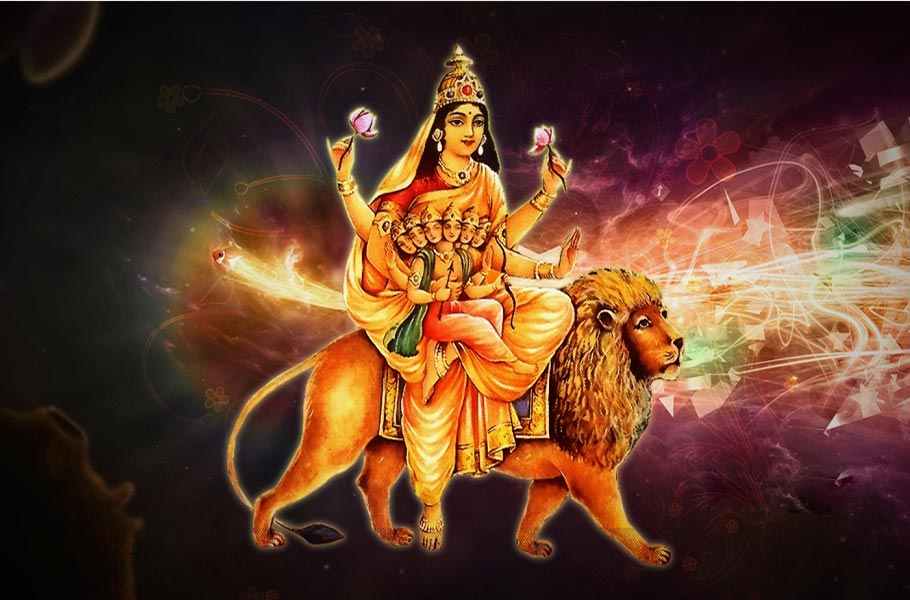 On the fifth day of Navaratri we celebrate Goddess in the form of Skandamata (literally the “mother of Skanda”). Skanda is a name for Kartikeya (also known as Murugun and Subramanya), the brother of Ganesha (both sons of Shiva and Parvati). We see Skandamata depicted holding her young six-headed son, as well as holding lotus flowers and keeping one hand in a blessing mudra. In worshiping her we call forth the protection and care that the Divine Mother has for all of creation, as all are her children. She blesses us with bliss, happiness, and motherly love, as well as nourishment and good health.
On the fifth day of Navaratri we celebrate Goddess in the form of Skandamata (literally the “mother of Skanda”). Skanda is a name for Kartikeya (also known as Murugun and Subramanya), the brother of Ganesha (both sons of Shiva and Parvati). We see Skandamata depicted holding her young six-headed son, as well as holding lotus flowers and keeping one hand in a blessing mudra. In worshiping her we call forth the protection and care that the Divine Mother has for all of creation, as all are her children. She blesses us with bliss, happiness, and motherly love, as well as nourishment and good health.
Kartikeya is the Lord of War, the leader of the army of devas (Gods) who fight the asuras (demons) in Hindu mythology. In the stories, the demon Tarakasura was tormenting all of humanity, and it was destined that only Lord Shiva’s son would be able to kill him and save the world. Shiva had renounced everything and was lost in meditation, however, after the death of his first wife, Sati. The Gods devised a plan and ensured that Parvati was born (a reincarnation of Sati), and followed a path that would result in Shiva’s emerging from meditation and remarrying. When they finally married, Shiva and Parvati ended up making love for millions of years while the world awaited their savior. Eventually, the fire deity, Agni, snuck into their cave in order to steal the seed that was needed. It was so hot that he could not hold it, however, and dropped it in the river Ganga (another manifestation of Goddess), who deposited the infant Skanda on her banks where he was found and nourished by six women (thus the six heads).
The demons represent the ignorance which gives rise to all human impurities and misfortune. In worshiping Skandamata we also worship Skanda and receive his blessings, including protection from harm and victory over our enemies, both internal and external. Skandamata relates to the vishuddhi (throat chakra), meaning “pure” or “undiluted,” showing that we can attain purity and realize infinite blessings through her worship. She is rules the planet Mercury (Budha), the planet and deity of communication and the intellect.
Sixth Day of Navaratri: Goddess as Katyayani
Sunday, October 18th
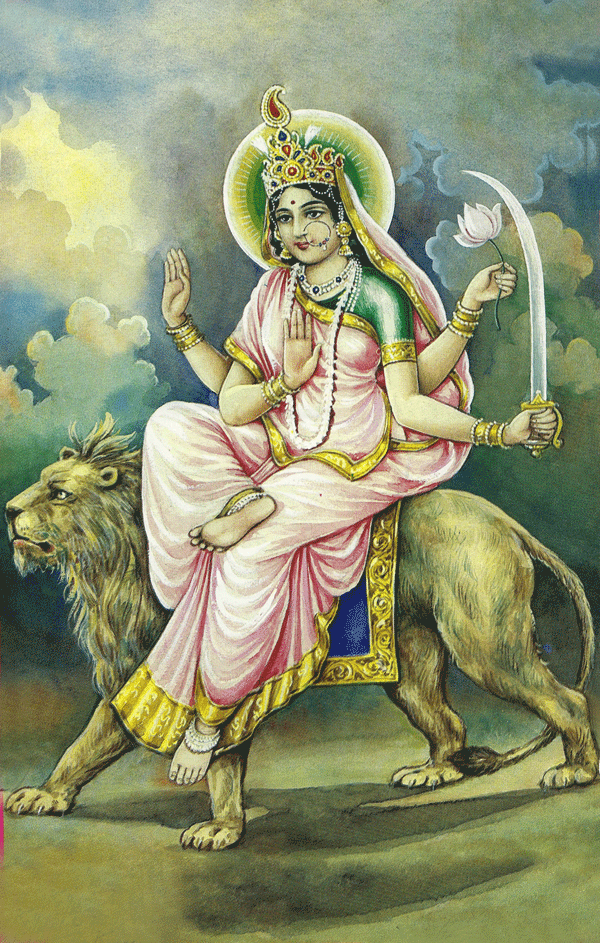 On the sixth day of Navaratri we celebrate Goddess in the form of Katyayani, the warrioress who destroyed Mahishasura (the buffalo demon). Mahishasura had been granted a boon (unbreakable wish) from Lord Brahma that determined that no man could kill him. Thus, when he was terrorizing the earth and heavens, the Gods summoned Goddess Durga to come and save them. This form of Durga is named Katyayani, for her father Katya, a devoted sage who did rigorous penance in order to have Durga take birth as his daughter. Katyayani takes a fierce form of the Divine Mother when we call upon her to destroy our demons, including both internal negativities and external obstacles to material and spiritual success. She relates to the ajna (the third-eye) chakra, where we draw our concentration during worship today.
On the sixth day of Navaratri we celebrate Goddess in the form of Katyayani, the warrioress who destroyed Mahishasura (the buffalo demon). Mahishasura had been granted a boon (unbreakable wish) from Lord Brahma that determined that no man could kill him. Thus, when he was terrorizing the earth and heavens, the Gods summoned Goddess Durga to come and save them. This form of Durga is named Katyayani, for her father Katya, a devoted sage who did rigorous penance in order to have Durga take birth as his daughter. Katyayani takes a fierce form of the Divine Mother when we call upon her to destroy our demons, including both internal negativities and external obstacles to material and spiritual success. She relates to the ajna (the third-eye) chakra, where we draw our concentration during worship today.
Katyayani relates to fervent devotion, and it is told that she was also worshipped by the Gopis of Vrindavan, who called on her to help them win Lord Krishna as their husband. It is said that worshiping Katyayani will help in bringing a good relationship and marriage, as she bestows the strength to remove obstacles. She also rules Jupiter (Guru), who represents husband in a woman’s astrological chart. Jupiter brings grace, expansion, and optimism, just as Katyayani helps us to fight sorrow and fear. Katyayani is related to fragrances, and offering her incense and other aromatics is a good practice to include in worship today. Through healing scents she helps us to fight disease and improve health. She holds both a lotus and a sword in two of her hands, and holds the other two in mudras offering protection and blessings.
Seventh Day of Navaratri: Goddess as Kalaratri
Monday, October 19th
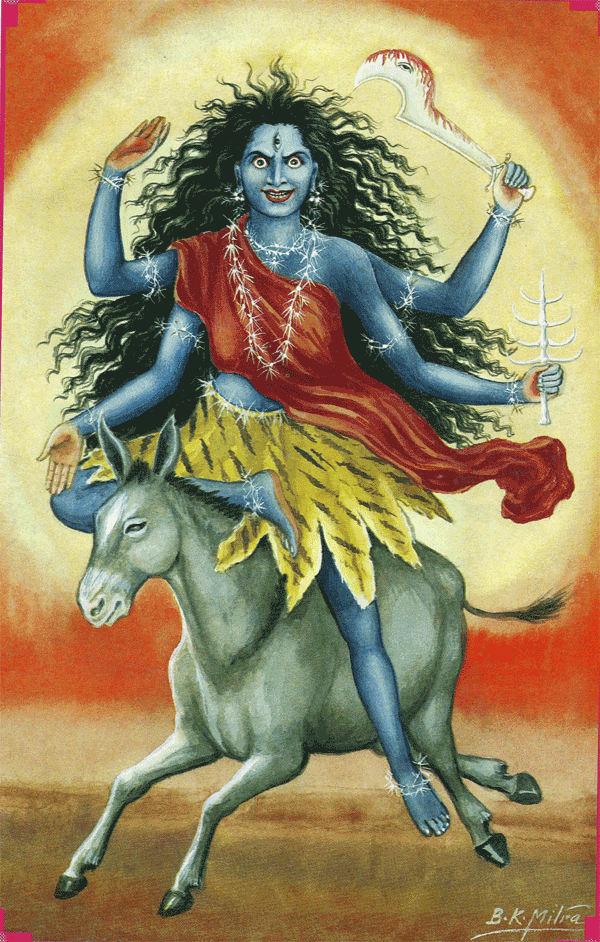 On the seventh day of Navaratri we worship Goddess as Kalaratri, a dark and fierce form of Durga. She has wild black hair, dark complexion, three red eyes, and flaming nostrils. She rides a donkey, and carries a sword and a cleaver in two hands, while her two other hands are in mudras offering blessings and protection. “Kala” refers to time, darkness, and therefore death. “Ratri” is night, and the presence of this goddess signifies a night of facing death and darkness. She reminds us that these are parts of the experience of life. By facing these aspects, and by worshipping Kalaratri, we can be freed from the pain and suffering associated with them. She is by our side bravely and compassionately as we face the morbid and terrifying aspects of existence, and helps to destroy our fears and weaknesses, giving us great strength.
On the seventh day of Navaratri we worship Goddess as Kalaratri, a dark and fierce form of Durga. She has wild black hair, dark complexion, three red eyes, and flaming nostrils. She rides a donkey, and carries a sword and a cleaver in two hands, while her two other hands are in mudras offering blessings and protection. “Kala” refers to time, darkness, and therefore death. “Ratri” is night, and the presence of this goddess signifies a night of facing death and darkness. She reminds us that these are parts of the experience of life. By facing these aspects, and by worshipping Kalaratri, we can be freed from the pain and suffering associated with them. She is by our side bravely and compassionately as we face the morbid and terrifying aspects of existence, and helps to destroy our fears and weaknesses, giving us great strength.
She is an expression of Kali, whose fearful form was birthed from Durga’s third eye when Durga needed more strength and ferocity to fight the demon Raktabija. She is also called Shubhankari, she who does auspicious deeds, and reminds us that we have nothing to fear from her, and nothing to fear, ever. The compassionate energy of the Divine Mother is always working through all parts of creation, even in the processes of destruction. Kalaratri rules Saturn (Shani), who also represents time and ultimate death, and offers us the opportunity for expanded consciousness through meditation on these inevitabilities. By worshiping Kalaratri on the seventh day of Navaratri and meditating on her deeply, we connect with the sahasrara (crown) chakra, and the barriers between mind, body, and spirit begin to dissolve. She blesses us with happiness and courage, helping to remove sadness, pain, and fear.
In some areas, the seventh day of Navaratri begins the worship of Sarasvati. Having worshipped Durga and Lakshmi for three days and nights each, to remove obscacles and obtain spiritual wealth. Now the devotee is ready to receive knowledge, which comes from Sarasvati, the goddess of learning. In other schools of worship, such as Kalikula in Nepal, Sarasvati is celebrated for the first three nights, followed by Lakshmi, and the last three nights are dedicated to Kali.
Eighth Day of Navaratri: Goddess as Mahagauri
Tuesday, October 20th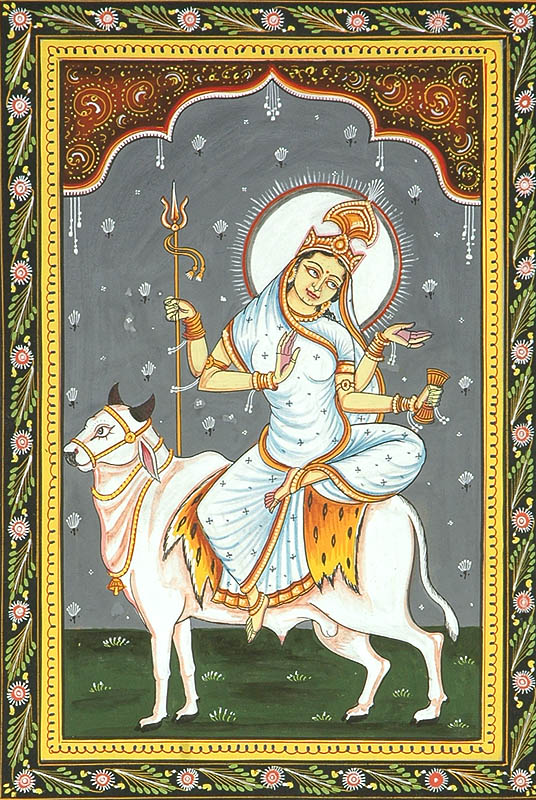
On the eighth day of Navaratri we worship Goddess as Mahagauri, the “great white goddess.” This incarnation of Durga is fair, shining and radiant like pure light, representing her purifying shakti. She rides a bull and carries a damaru (a hand-drum) and a trisul in two hands, keeping the other two in mudras for blessing and protecting. She represents compassion, truth, and purity and bestows these on her devotees. Mahagauri is often thought of as the young form of Parvati, and thus worshipers often feed young girls sweets on this day of celebration, to honor the great white goddess.
The story is often told that while Parvati was doing penance to win Lord Shiva, her body became black and dirty. When Shiva accepted her he washed her with the water of the Ganga which made her shine resplendently and become Mahagauri. This represents her power to free us from all pain and suffering and to bless us with auspiciousness and virtues, those who bathe in the waters of the holy river Ganga are said to be blessed and purified. This includes freeing us from the painful attachments to the material world. As we worship Mahagauri only after the night of worship dedicated to Kalaratri, we can see that this detachment and reemergence into the light can come only after facing death and darkness. This goddess relates to the planetary deity Rahu (the north node of the Moon), who is actually a shadow point in the cosmos and has no physical body. Thus Mahagauri relates to parts of our soul and psyche that are beyond the physical body or chakra system. By making offerings to and meditating upon her, we can begin to go beyond our attachments to the mundane details of life and purify our connection with spirit.
Ninth Day of Navaratri: Goddess as Siddhidatri
Wednesday, October 21st
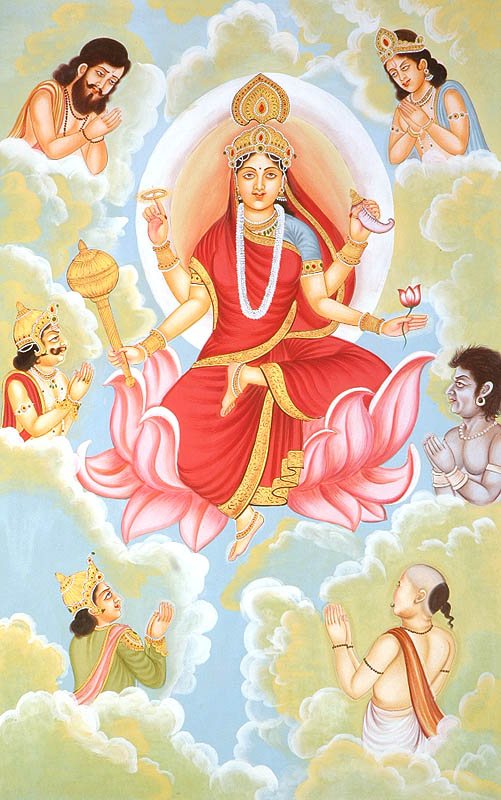 The ninth day of Navaratri is of utmost importance. On this day we worship Goddess as Siddhidatri, the giver of all siddhis, special powers or perfect attainments. Siddhis are magical, spiritual, or psychic powers, attained through dedication and devoted practice. Through worship and meditation upon all the forms of Durga, culminating with that of Siddhidatri, we can attain perfection and infinite blessings from her. Through the siddhis, all desires can be fulfilled. But it is said the greatest blessing one can receive is to transcend all desires, or to have one’s only desire be to know Goddess/God. With the blessing of devotion, through her grace, we can remain peaceful and happy in all circumstances, blissfully experiencing the Divine Mother’s presence in and throughout all of creation, in every moment.
The ninth day of Navaratri is of utmost importance. On this day we worship Goddess as Siddhidatri, the giver of all siddhis, special powers or perfect attainments. Siddhis are magical, spiritual, or psychic powers, attained through dedication and devoted practice. Through worship and meditation upon all the forms of Durga, culminating with that of Siddhidatri, we can attain perfection and infinite blessings from her. Through the siddhis, all desires can be fulfilled. But it is said the greatest blessing one can receive is to transcend all desires, or to have one’s only desire be to know Goddess/God. With the blessing of devotion, through her grace, we can remain peaceful and happy in all circumstances, blissfully experiencing the Divine Mother’s presence in and throughout all of creation, in every moment.
In her depiction, Siddhidatri sits on a lotus or a lion and holds a discus, a lotus, a mace, and conch shell, which she will use to sound the victory we attain through her worship. She is surrounded by and worshipped by all forms of divine beings–Gods, demons, spiritual masters and nature-spirits. It is said that even Lord Shiva received his powers from Siddhidatri. In the divine form that is half Shiva and half Shakti, he is merged with Siddhidatri and known as Ardhanarishvara. Siddhidatri relates to Ketu (the south node of the Moon), and thus she governs our deep and ancient psychic wisdom. She is a powerful goddess to worship for enhancing spiritual, psychic and energetic healing powers.
The Tenth Day of Navaratri: Vijayadashami
Thursday, October 22nd
The tenth day of Navaratri is known as Vijayadashami, the day of victory. After calling upon the Divine Mother’s presence and qualities to arise from within us for nine days and nights, we emerge victorious, basking in Her light and virtues. This is an auspicious time for beginning new ventures, especially creative and spiritual pursuits.
Jai Ma Durga!
I offer personal Vedic Astrology readings which can provide insight into the aspects of Shakti as well as the planetary forces you can work with in order to understand and master your personal strengths, challenges, and life course better. Click Here to order a reading and sign up for free Vedic Astrology news!
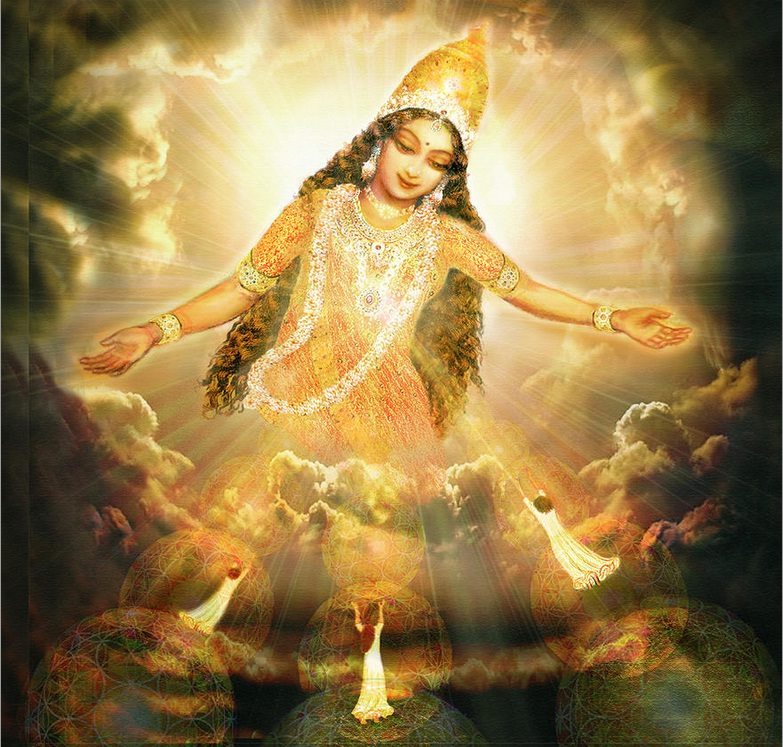
by Somya Devi | Oct 10, 2015 | Astrology, Conjunctions, Events, Holy Days
New Moon in Virgo in Chitra Nakshatra and Navaratri
As we complete the most recent lunar cycle which brought two powerful eclipses, we are settling into the effects and transformation that they brought to our lives. The solar and lunar eclipses of September were the last of a series to occur with the nodes in sidereal Virgo and Pisces, where they have sat since July 2014. Lessons that we have been working on through this time have taken on a new light, and many of us are now ready to face change and growth, whether it be in career, relationships, residence, or other important areas of life that have recently transformed.
 The New Moon in Virgo in Chitra nakshatra occurs on October 12th and offers us a day (and night) of stillness and darkness to sit with the changes, go inward and reflect, and prepare for the next lunar cycle. This Dark Moon phase will be from around 3pm PDT on October 11th until 5:05 pm on October 12th, at which time the Moon and Sun will be at a conjunct longitude (commonly called the New Moon). This conjunction happens near the end of Virgo constellation, in the Vedic nakshatra called Chitra. After that point the Moon begins its waxing phase, and the new lunar month.
The New Moon in Virgo in Chitra nakshatra occurs on October 12th and offers us a day (and night) of stillness and darkness to sit with the changes, go inward and reflect, and prepare for the next lunar cycle. This Dark Moon phase will be from around 3pm PDT on October 11th until 5:05 pm on October 12th, at which time the Moon and Sun will be at a conjunct longitude (commonly called the New Moon). This conjunction happens near the end of Virgo constellation, in the Vedic nakshatra called Chitra. After that point the Moon begins its waxing phase, and the new lunar month.
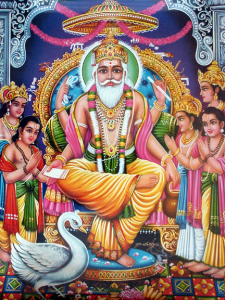 Chitra means “the brilliant” and is a very creative place in the zodiac. The deity for Chitra is Vishvakarma, the divine architect of the cosmos. This month we will feel inspired to create and to perfect our creations, just as the architect creates the universe in perfection. We will be attracted to investigate the mystery behind that divine creation. Gemstone medicine is powerful now, as gems are a symbol of this star. Chitra also relates to magic, and it is a time to tap into the powerful forces of magic within ourselves, and let them shine brightly.
Chitra means “the brilliant” and is a very creative place in the zodiac. The deity for Chitra is Vishvakarma, the divine architect of the cosmos. This month we will feel inspired to create and to perfect our creations, just as the architect creates the universe in perfection. We will be attracted to investigate the mystery behind that divine creation. Gemstone medicine is powerful now, as gems are a symbol of this star. Chitra also relates to magic, and it is a time to tap into the powerful forces of magic within ourselves, and let them shine brightly.
Beginning this cycle in Virgo, and with Sun and Moon joined with exalted Mercury there, we feel Mercury’s influence compelling us to seek understanding, and to organize the details around our creative pursuits. The second half of Chitra falls in Libra (as will the Sun during much of this lunar cycle), and under Venus’s influence, we may also feel called to balance our relationships this month. Mars is the nakshatra ruler for this star, and he brings us an energy, along with the fire element, that helps fuel along our creativity. There may be more emphasis on sexuality this cycle. Chitra is itself a balancing point in the zodiac, being the middle (14th) of the 27 nakshatras, so we seek harmony in all things as we prepare for the next season.
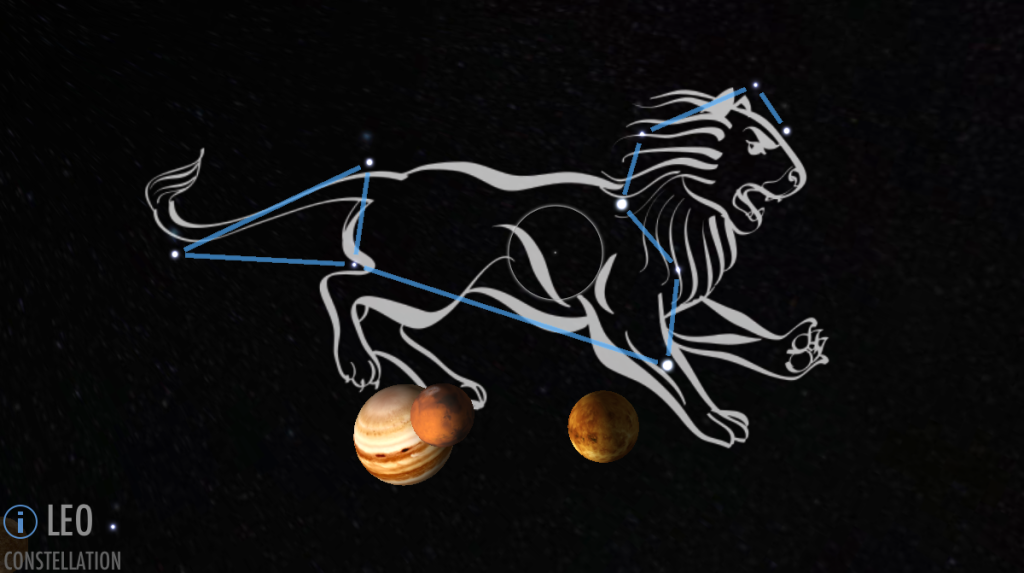 For most of this cycle (through November 2nd), we also experience the influence of Jupiter, Venus, and Mars all joined in Leo. This will make us give a lot of importance to the things all three of these planets represent (beliefs, desires, and personal will). At times this could create conflict (especially when they pass over each other in close conjunction), but in general it gives us a lot of energy. Jupiter in Leo energizes our belief systems, giving our philosophies a lot of weight in our decision-making process. Venus in Leo makes our desires come to the forefront, and we must be careful not to be too indulgent or selfish when it comes to getting what we want (whether it be in relationships or in our pursuit of beauty and recreation). Mars in Leo adds extra fire to the planet of action, will and energy, which could be good for our personal physical discipline, but could also cause us to get aggravated and argumentative over our philosophies and desires. Turn that Martian energy on yourself instead of getting hot-headed with others (read: time to reboot your workout routine or asana practice!). Sun’s rulership of Leo gives us the opportunity to work on purifying and refining all of these things this month–our beliefs, our desires, and our instinctual energy driver.
For most of this cycle (through November 2nd), we also experience the influence of Jupiter, Venus, and Mars all joined in Leo. This will make us give a lot of importance to the things all three of these planets represent (beliefs, desires, and personal will). At times this could create conflict (especially when they pass over each other in close conjunction), but in general it gives us a lot of energy. Jupiter in Leo energizes our belief systems, giving our philosophies a lot of weight in our decision-making process. Venus in Leo makes our desires come to the forefront, and we must be careful not to be too indulgent or selfish when it comes to getting what we want (whether it be in relationships or in our pursuit of beauty and recreation). Mars in Leo adds extra fire to the planet of action, will and energy, which could be good for our personal physical discipline, but could also cause us to get aggravated and argumentative over our philosophies and desires. Turn that Martian energy on yourself instead of getting hot-headed with others (read: time to reboot your workout routine or asana practice!). Sun’s rulership of Leo gives us the opportunity to work on purifying and refining all of these things this month–our beliefs, our desires, and our instinctual energy driver.
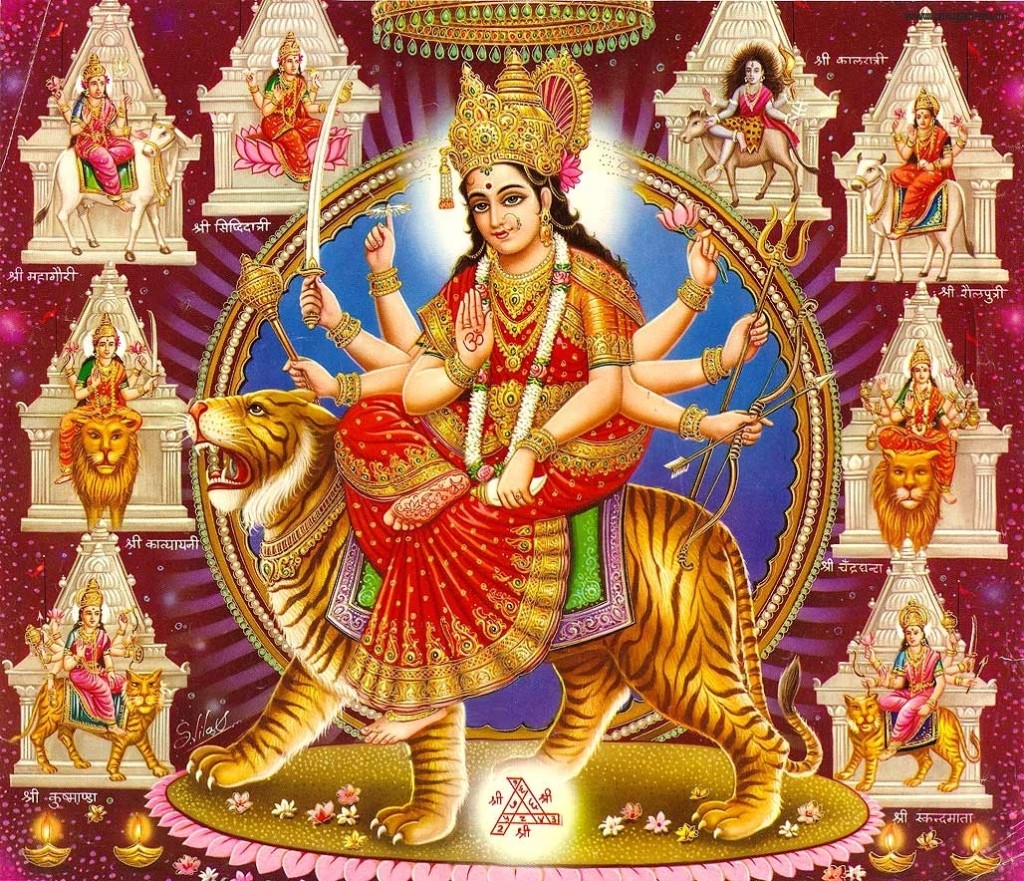 During the first nine days and nights of the waxing Moon this month, Navaratri is celebrated (starting October 13th in North America). Literally the “nine nights,” this is a Hindu festival dedicated to worshiping the Goddess, Devi, in her many forms, for nine days and nights. As the night represents darkness and ignorance, we pray to her to help reveal and remove our shortcomings, bestow blessings, and confer wealth and knowledge. We face the darkness and call on the Divine Mother to remove it and let the Atma, or the pure divinity within each of us, shine forth. Navaratri worship can include creating a special altar to the Goddess, and making daily offerings including flowers, food, incense, light (a flame), ghee, as well as prayer, fasting, meditation, mantras and bhajans (devotional songs). The Devi Mahatmya (a.k.a. Chandi Path), the story of Durga, is a traditional text to read throughout this festival. In some places Devi is worshipped over the nine nights in reverence to nine incarnations of Durga: Shailputri, Brahmacharini, Chandraghanta, Kushmanda, Skandamata, Katyayani, Kalaratri, Mahagauri and Siddhidatri. Occurring in the fall-time in India and the northern hemisphere, this Navaratri also coincides with the harvest season, and is a great time to give thanks for the abundance of the harvest and pray that it carries us through the winter season.
During the first nine days and nights of the waxing Moon this month, Navaratri is celebrated (starting October 13th in North America). Literally the “nine nights,” this is a Hindu festival dedicated to worshiping the Goddess, Devi, in her many forms, for nine days and nights. As the night represents darkness and ignorance, we pray to her to help reveal and remove our shortcomings, bestow blessings, and confer wealth and knowledge. We face the darkness and call on the Divine Mother to remove it and let the Atma, or the pure divinity within each of us, shine forth. Navaratri worship can include creating a special altar to the Goddess, and making daily offerings including flowers, food, incense, light (a flame), ghee, as well as prayer, fasting, meditation, mantras and bhajans (devotional songs). The Devi Mahatmya (a.k.a. Chandi Path), the story of Durga, is a traditional text to read throughout this festival. In some places Devi is worshipped over the nine nights in reverence to nine incarnations of Durga: Shailputri, Brahmacharini, Chandraghanta, Kushmanda, Skandamata, Katyayani, Kalaratri, Mahagauri and Siddhidatri. Occurring in the fall-time in India and the northern hemisphere, this Navaratri also coincides with the harvest season, and is a great time to give thanks for the abundance of the harvest and pray that it carries us through the winter season.
In some places, the first three nights of Navaratri are dedicated to Goddess in the form of Durga or Kali, who help us to destroy and remove negative tendencies in our minds and hearts, cleansing them of impurities that create obstructions in our spiritual and material pursuits. The next three nights are dedicated to Goddess in the form of Lakshmi, who helps us to cultivate positive qualities, like compassion and devotion. She helps us to achieve spiritual and material prosperity. In the final three nights we worship Goddess as Sarasvati, who assists us with learning and attaining knowledge and wisdom, through the illumination of consciousness. She relates to prana, the vital breath, often associated with chi or life-force. Through our devotion, service, practice, study, and meditation (all forms of yoga), we allow prana to flow freely, helping us to exist in a state of peace, bliss, and oneness. The tenth day of Navaratri is known as Vijayadashami, the day of victory. After calling upon the Divine Mother’s presence and qualities to arise from within us for nine days and nights, we emerge victorious, basking in Her light and virtues. This will be an auspicious time (October 22nd) for beginning new ventures, especially creative and spiritual pursuits.

by Somya Devi | Jul 15, 2015 | Astrology, Conjunctions, Planets Changing Signs
The New Moon initiates our next lunar cycle tomorrow, July 15th, at 6:25pm PDT, from the very end of sidereal Gemini (29 degrees). Sun, Moon, Mercury and Mars will all be joined in the lunar mansion (nakshatra) called Punarvasu, a star-sign that symbolizes renewal and abundance. This energy accompanies Jupiter’s very recent transition from Cancer into Leo, whence he will shine for the next year or so, bringing grace and hope to a powerful position in the heavens.
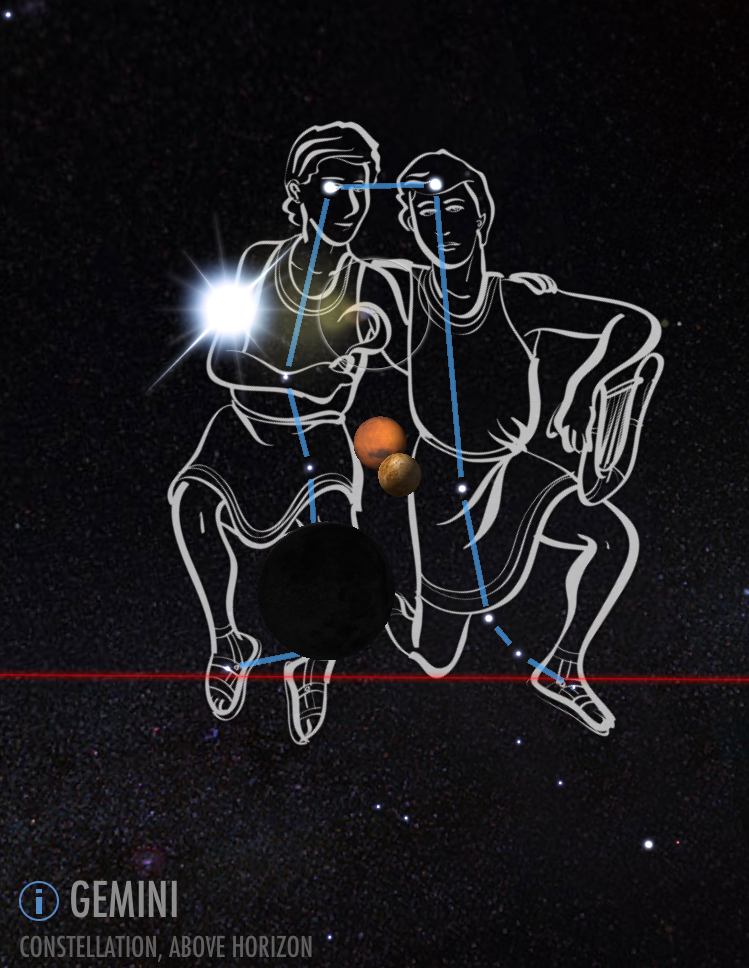 Punarvasu comes from the root words “Punar” meaning “again” or “repeatedly,” and “vasu” meaning “light” in this instance. Therefore this nakshatra’s cycle is a place where we can find “light again,” (which follows naturally as Punarvasu comes after the nakshatra Ardra, a place of storms, tears and raindrops). It symbolizes the renewal and regrowth that comes after a storm or heavy rain. The ruler of Punarvasu is Jupiter, who brings optimism and expansion. Its deity is Aditi, the mother of all the Gods in Hindu mythology, who symbolizes wealth and abundance. In this cycle we may feel a lot of ambition and drive, and it is a great time to harness the opportunity for a fresh start and renewed abundance in most pursuits.
Punarvasu comes from the root words “Punar” meaning “again” or “repeatedly,” and “vasu” meaning “light” in this instance. Therefore this nakshatra’s cycle is a place where we can find “light again,” (which follows naturally as Punarvasu comes after the nakshatra Ardra, a place of storms, tears and raindrops). It symbolizes the renewal and regrowth that comes after a storm or heavy rain. The ruler of Punarvasu is Jupiter, who brings optimism and expansion. Its deity is Aditi, the mother of all the Gods in Hindu mythology, who symbolizes wealth and abundance. In this cycle we may feel a lot of ambition and drive, and it is a great time to harness the opportunity for a fresh start and renewed abundance in most pursuits.
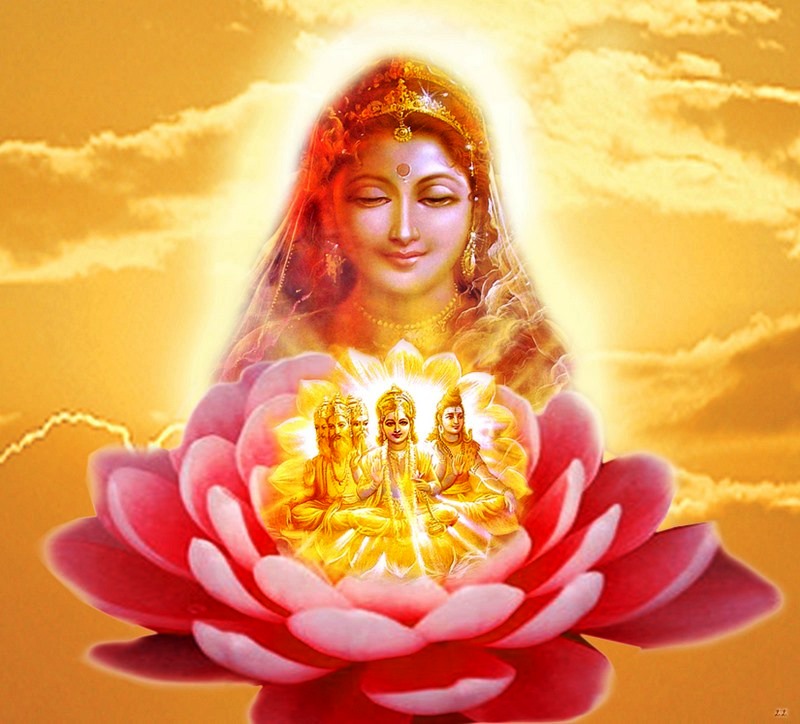
In addition to Punarvasu’s graceful energy, Jupiter transitioned from Cancer into Leo on Monday, July 13th, where he will serve a powerful dose of energy to us for the next year. Leo is ruled by the Sun, the primordial, pure life-force behind all consciousness, and is a place of power in the zodiac. Jupiter, another sattvic planet, is well-placed here. Sun in his highest sense offers us illumination and the opportunity for embodying our higher potential. Under Sun’s rulership, Jupiter may be able to direct much positive expansion and philosophical influence to us from Leo. If well-channeled and applied, this dose of philosophy and optimism could yield wisdom, abundance and generosity. On the other hand, we may experience people getting really heated over their beliefs, as this position strengthens Jupiter’s potential for dogmatism. Jupiter will have a particularly strong influence on people with rising fire-signs (Leo, Sagittarius, and Aries) this year, and will be enhancing specific activities for every individual, depending on your Vedic rising sign and which houses he rules for you.
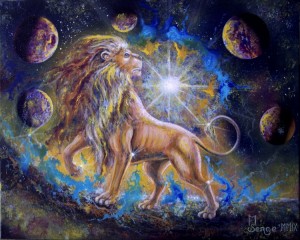 Venus also moved from Cancer to Leo, last week, but faces a more strained relationship under Sun’s rulership than Jupiter does. The highest side of Sun compels us to freely share our love, like the Sun does endlessly without request for anything in return, (in his awareness of himSelf as an infinite source of energy). Venus, on the other hand, drives the part of us that seeks pleasure for ourselves, especially in relationships. Venus in Leo could compel us to act like a king or queen in our relationships, as it struggles to get past the immensity of power encountered here, and perhaps forgets the usual methods of compromising (since one person’s happiness can’t really come at the cost of another’s in relationships, at least not for long). If we stay on a course of self-inquiry, it will be possible that this placement could help illuminate more self-love, which in turn can be shared abundantly with all those around us. Saturn is also casting his gaze on Jupiter and Venus as long as they are in Leo, bringing us more ability to look at these planets’ energies with long-term vision.
Venus also moved from Cancer to Leo, last week, but faces a more strained relationship under Sun’s rulership than Jupiter does. The highest side of Sun compels us to freely share our love, like the Sun does endlessly without request for anything in return, (in his awareness of himSelf as an infinite source of energy). Venus, on the other hand, drives the part of us that seeks pleasure for ourselves, especially in relationships. Venus in Leo could compel us to act like a king or queen in our relationships, as it struggles to get past the immensity of power encountered here, and perhaps forgets the usual methods of compromising (since one person’s happiness can’t really come at the cost of another’s in relationships, at least not for long). If we stay on a course of self-inquiry, it will be possible that this placement could help illuminate more self-love, which in turn can be shared abundantly with all those around us. Saturn is also casting his gaze on Jupiter and Venus as long as they are in Leo, bringing us more ability to look at these planets’ energies with long-term vision.
Watch for Venus to turn Retrograde on July 25th. At this point we may really start looking at our relationships and the way we go about seeking beauty and pleasure in life. Love relationships could slow down a little, or the power-tripping could if that is an issue that arises for you with Venus in Leo. Now is a great time to harness the Sun’s illumination on both Venus and Jupiter (who informs our philosophies and most valued teachings). While this source energy is strong, tap into it in your meditations and reflect on how you can do the most good with the power you have been given. Venus will cross directly over Jupiter again on August 6th, which will be beautiful but may cause us to feel the dichotomy between relationships and personal philosophy again.
 Be aware that Mercury is both combust and tightly conjunct with Mars during this New Moon in Punarvasu. This tight a conjunction makes a planetary war that can cause stress between the two forces within us, where intellect and instinct struggle for dominance. It could make for some heated discussions. Try to wait a day or two if you’re feeling hot-hearted or -headed, for these two to separate a little, before launching into anything you feel torn up about. On the 16th, Sun and Moon tip over the Gemini-Cancer line (still in Punarvasu nakshatra) into Cancer, and Mars and Mercury will be starting to separate. This will be a good time to start putting your renewal efforts into action, before Mars goes debilitated (into Cancer) on July 30th. In this water-sign, with so much comforting, nurturing, motherly-love energy, it can be harder to call forth Mars’ courage and assertiveness into our endeavors and actions.
Be aware that Mercury is both combust and tightly conjunct with Mars during this New Moon in Punarvasu. This tight a conjunction makes a planetary war that can cause stress between the two forces within us, where intellect and instinct struggle for dominance. It could make for some heated discussions. Try to wait a day or two if you’re feeling hot-hearted or -headed, for these two to separate a little, before launching into anything you feel torn up about. On the 16th, Sun and Moon tip over the Gemini-Cancer line (still in Punarvasu nakshatra) into Cancer, and Mars and Mercury will be starting to separate. This will be a good time to start putting your renewal efforts into action, before Mars goes debilitated (into Cancer) on July 30th. In this water-sign, with so much comforting, nurturing, motherly-love energy, it can be harder to call forth Mars’ courage and assertiveness into our endeavors and actions.
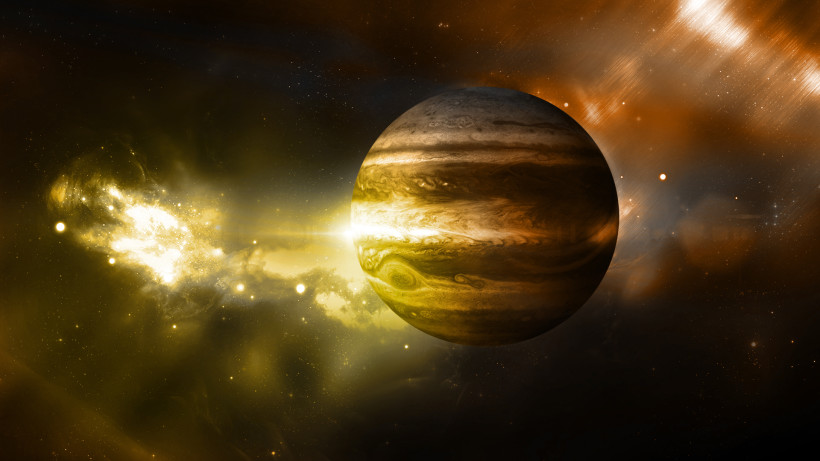 Overall, we will be feeling a surge of optimism, effort, and drive towards abundance this cycle. With the start of Jupiter’s new year in Leo, we are all likely to feel a major shift as the teacher of the Gods moves into the all-powerful Sun’s house, which could shine a lot of light, energy, and clarity on our hopes, dreams and beliefs. Each rising sign will experience this strength in a particular area of life (or three). Sign up for a reading today to find out which of your strengths are ripening for an extra juicy harvest this year!
Overall, we will be feeling a surge of optimism, effort, and drive towards abundance this cycle. With the start of Jupiter’s new year in Leo, we are all likely to feel a major shift as the teacher of the Gods moves into the all-powerful Sun’s house, which could shine a lot of light, energy, and clarity on our hopes, dreams and beliefs. Each rising sign will experience this strength in a particular area of life (or three). Sign up for a reading today to find out which of your strengths are ripening for an extra juicy harvest this year!
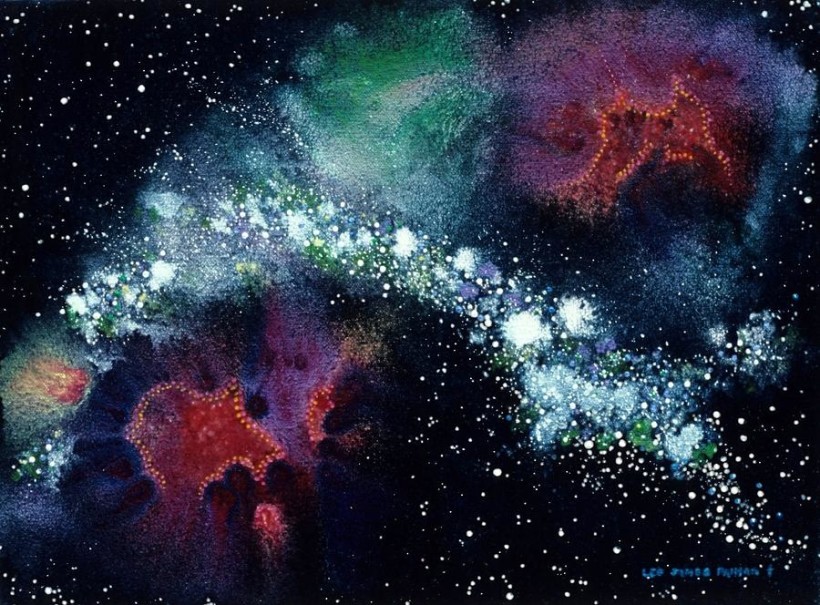
by Somya Devi | Jun 15, 2015 | Astrology, Planets Changing Signs
 The New Moon will occur Tuesday morning at 7:05am PDT, in early sidereal Gemini (Sun and Moon at 1 degree 3 minutes Gemini). This begins the Gemini Moon cycle for the next month. Mercury rules Gemini, so we will deal with the themes of the intellect a lot this cycle. We may see our thinking accelerate and new ideas synthesize, as well as a deeper exploration of communication. It’s a time to look out for vata, as the swiftness of Mercury and its air-sign Gemini can elevate that dosha in the mind and body. Staying hydrated and well oiled is important (internally and externally), as well as doing grounding practices that connect you to the earth. Applying oil to the bottoms of the feet will be very nourishing, or to the entire body before you shower.
The New Moon will occur Tuesday morning at 7:05am PDT, in early sidereal Gemini (Sun and Moon at 1 degree 3 minutes Gemini). This begins the Gemini Moon cycle for the next month. Mercury rules Gemini, so we will deal with the themes of the intellect a lot this cycle. We may see our thinking accelerate and new ideas synthesize, as well as a deeper exploration of communication. It’s a time to look out for vata, as the swiftness of Mercury and its air-sign Gemini can elevate that dosha in the mind and body. Staying hydrated and well oiled is important (internally and externally), as well as doing grounding practices that connect you to the earth. Applying oil to the bottoms of the feet will be very nourishing, or to the entire body before you shower.
It’s also a time to be aware of high pitta, the fire-dosha, as the Sun and Mars are also tightly conjunct right now. This is what we call a highly combust Mars, as it is only half a degree away from the Sun in early Gemini at the time of the New Moon. This can be incredibly aggravating, as these two fire planets joined increases the heat in our bodies and minds and can cause us to feel easily provoked and prone to anger and explosions. To alleviate pitta imbalances, we can avoid spicy foods during this time, and eat cooling ones such as cucumber, coconuts, and watermelon. Make sure to intake enough liquids and use coconut oil rather than more heating oils for internal and external use. Lavender, tulsi, and rose essential oils are all calming and cooling to the body-mind, and can be used for aromatherapy by placing a drop or two on the pillowcase at night or in a diffuser in your home or office. You can also make a tea from the dried petals and leaves of these aromatic plants.
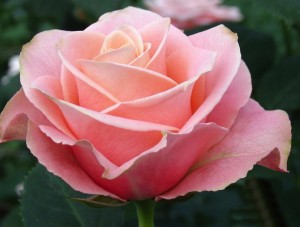
Rose is especially helpful in this time because of its ability to soothe and balance the heart and emotions, which could feel overwhelming right now. With New Moon so close to Sun and Mars, there is the potential for their fire to weigh on the heart in the form of passion or frustration/anger. At the same time we have Venus joined with Jupiter in Cancer, which expands Venus’s potential for love and happiness, and also raises the importance we place on it and makes us weigh it closely against our values. Jupiter is our potential for wisdom and higher thought or spiritual understanding. With these two in the feminine Moon-ruled sign of Cancer, we can really tap into some Divine Mother/heart-energy if we seek happiness and through spiritual practice. If we let Jupiter’s expansive quality push us to seek material pleasures too much, we will inevitably be disappointed as time goes on, as these are all temporary. Tulsi can help us to orient our love towards a place of devotion. Jupiter and Venus will be really close in the sky for most of the coming month (very tightly conjunct around June 30th), and incredibly beautiful to witness in the night sky. They will be close with the Moon in Cancer at the end of this week… a great time for open-hearted prayers.
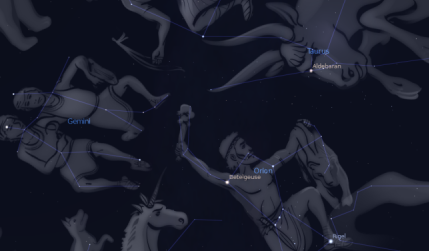 There is the potential to feel an urgent sense of seeking during this New Moon, which falls in the Vedic nakshatra Mrigashira, located around the star Bellatrix, (on the shoulder of Orion, in the region of the sky bridging Taurus and Gemini). Mrigashira is the star of the deer’s head, often referred to as “the wanderer,” continuously searching with curiosity. Though there is a beauty and innocence to this, the restlessness of
There is the potential to feel an urgent sense of seeking during this New Moon, which falls in the Vedic nakshatra Mrigashira, located around the star Bellatrix, (on the shoulder of Orion, in the region of the sky bridging Taurus and Gemini). Mrigashira is the star of the deer’s head, often referred to as “the wanderer,” continuously searching with curiosity. Though there is a beauty and innocence to this, the restlessness of 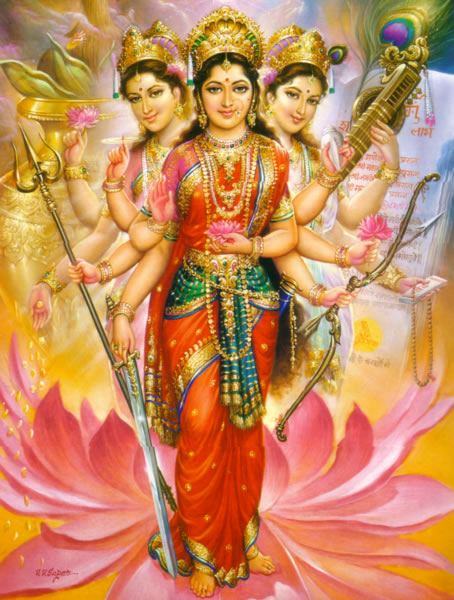 this star can also interfere with our ability to stay focused and one-pointed. Its deity is Soma, a name for the Moon, and the Moon as it relates to our emotional mind can be easily changeable. Mrigashira also represents many positive qualities of the Moon, which is beautiful, gentle, calming, and full of compassion and Divine Mother energy. This star is also associated with Parvati, the wife of Shiva in Hindu mythology and a powerful representation of the goddess. This is a great time to get in tune with all aspects of the goddess, from the most gentle, motherly form, to the strong-willed warrior aspects of Durga and the fierce and compassionate nature of Kali (both forms of Parvati).
this star can also interfere with our ability to stay focused and one-pointed. Its deity is Soma, a name for the Moon, and the Moon as it relates to our emotional mind can be easily changeable. Mrigashira also represents many positive qualities of the Moon, which is beautiful, gentle, calming, and full of compassion and Divine Mother energy. This star is also associated with Parvati, the wife of Shiva in Hindu mythology and a powerful representation of the goddess. This is a great time to get in tune with all aspects of the goddess, from the most gentle, motherly form, to the strong-willed warrior aspects of Durga and the fierce and compassionate nature of Kali (both forms of Parvati).
In Vedic thought Soma also refers to the nectar released through meditation. In this we can again see this New Moon as a call to stay hydrated in order to nourish the water element in our bodies, which is the conduit for the flow of all nutrients, including the physical and the spiritual. We can follow the searching nature of this star and the present alignments on a path to find new experiences, relationships, or temporary pleasures, or on a search for higher knowledge, wisdom, and heart-opening. Call forth the gentle energy of Mrigashira to appease the heat of combust Mars. Stay cool as much as possible and nourish the heart during this month of powerful celestial combinations.
